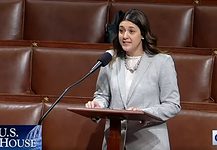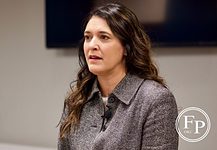Last Updated on February 1, 2020, 5:56 PM | Published: February 1, 2020

Nearly a century before Oklahoma became a state, a Massachusetts governor created a system that would help secure a seemingly permanent majority for one party in Oklahoma.
In 1812, Massachusetts governor Edmund Gerry took on a massive redistricting project with the hopes of securing long-term success for the Democratic-Republican Party founded by Thomas Jefferson and James Madison.
Based on demographics and past electoral performance, Gerry rejiggered his state’s districts, including one district on the west and north edges of Boston that looked a lot like a salamander.
As a result, a shameful practice of creating favorable conditions for one party while disenfranchising the other came into practice. Named for Gerry and his twisted, salamander-like Boston district, a local paper labeled it “gerrymandering,” and 208 years later, it still slimes our elections.
Opinion
From George Lang, our lead opinion columnist
Not surprising to anyone living in this state, a 2019 University of Southern California study of states with the worst party-drawn gerrymandering found that Oklahoma tied for No. 8 with its neighbor, Arkansas.
Rather than studying actual boundaries of state house and senate districts, the USC report covered statewide party voting in relation to distribution of power in the house. While Republicans dominated statewide voting in 2018 with 58.9 percent of votes, Republican representation in the House was at 76.2, giving Republicans a 17.3 percent advantage in state House representation over and above the actual popular vote tallies.
Then again, a look at Oklahoma County’s district map is telling in how populations are split to maintain political power in the state House by making the populations of each district as homogeneous as possible. The county’s House districts tend to be demographically lopsided to maintain a representational status quo, and look like a 6-year-old defaced an Oklahoma County map with a can of silly string.
House District 99 is a gerrymandering wonder. This carefully carved district’s northwestern tip is at NW 122nd St. and Pennsylvania Avenue. From there, it dips down into a narrow north-south corridor that is sometimes only five blocks wide as it travels southward through the state Capitol complex, then suddenly widens to cover about 10 square miles below NE 23rd Street that covers neighborhoods surrounding NE 10th Street and Kelly Avenue.
As a result of this geography-defiant, obviously demographically skewed piece of gerrymandering, District 99 is 61 percent African-American, while neighboring District 83 is 73 percent white. This can be seen by perfectly reasonable people as a way of providing representation to as many different types of people as possible, but the end results are that Oklahoma is unconscionably divided and poorly represented.
Real representation does not come from walling different races or levels of wealth from one another. Under extreme gerrymandering, state representatives avoid being answerable to everyone in their districts because the demographics are lopsided. Entire communities are disenfranchised and left with virtually no real representation, and dominant political parties are able to push their agendas with virtually no chance of a close vote.
State Question 804*, a proposed initiative petition also known as People Not Politicians, seeks to empower an independent and nonpartisan group to oversee redistricting in the wake of the 2020 census and end the practice of gerrymandering.
Supporters of the measure include League of Women Voters and Let’s Fix This OK, while opponents include Oklahoma Republican Party chairman David McLain and State Sen. Greg Treat, who said he was adamantly opposed to the question at the Jan. 30 Oklahoma City Chamber of Commerce legislative breakfast.
Treat represents state Senate District 47, which is shaped like a B2 stealth bomber thanks to the wonders of gerrymandering. He happens to be my state senator, and it only makes sense that Treat would want to maintain his district as is. After all, as a Republican in a blood-red conservative district with 76 percent white constituency, Treat is safe and secure in his seat, but any changes that might make the district less homogeneous could make his electability more of an up-in-the-air proposition.
We as a state should fight for a body politic in which there are few foregone conclusions. Representatives should have to respond to a heterogeneous constituency with many different concerns and needs. This is a necessary ingredient for an Oklahoma that achieves real progress instead of stultifying stasis, and Oklahomans should not settle for anything less.
*Correction: The original version of this article listed the state question as “801”. It is 804. Our apologies.
George Lang has worked as an award-winning professional journalist in Oklahoma City for over 25 years and is the professional opinion columnist for Free Press. His work has been published in a number of local publications covering a wide range of subjects including politics, media, entertainment and others. George lives in Oklahoma City with his wife and son.











